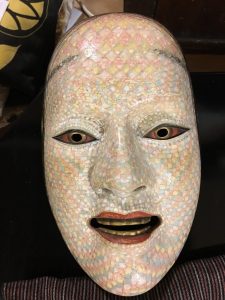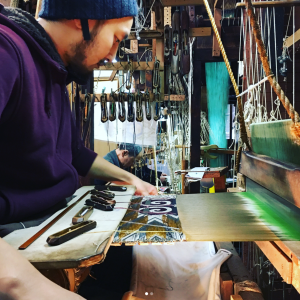Today we left at 9:30 to see the last two Artisans of the programme. As my group was focused on Noh Performers, I was quite excited to learn about the costumes and masks that are used in Noh Performances. We first stopped by the home of Noh mask maker Ohtsuki Kokun. Oktsuki-sensei told us of his personal life and the events that led up to him becoming a mask maker. After graduating highschool he worked for one year at an unrelated company, before deciding to travel to Kyoto to ask a a buddhist carver to allow him to become a pupil. He said he came prepared with a knapsack in the event he would be rejected, then he would sleep on the doorstep until the master yielded. Luckily, he was accepted for tutelage. He would work in the mornings making broth, and in the evenings practicing his carving skill. He was given the task to practice carving masks as they are not quite 3d dimensional, and he never turned back. Oktsuki-sensei told us that since then he has not deviated from mask carving, as he believes diverting from this specific skill set will weaken his overall talent in mask carving. That

Fox Woman
being said, he doesn’t strictly work on offical Noh Masks, but also invents his own, either for existing Noh plays, or for Noh plays he has imagined. He is currently in the process of writing a Noh Play for a blind woman mask. I like the fact that he made a blind woman mask – as I feel like alot of the female noh masks (aside from jealous woman) are often created with their beauty being the central focus. This instead is a character that has another layer to her persona. It was also interesting to see another one of his masks take into consideration the spatial element of a modern day Noh theatre, as another mask was created with a checkered skin, all the checkered spots from afar blend together to form an illusion of skin tone. This is to represent a fox who is pretending to be a lovely woman to win the heart of a superior and it is only until you’re quite close to the woman that you will be able to see past the illusion the fox and checkered pattern has created. We had also learnt about new innovations that Oktsuki-sensei came up with to answer questions/problems that arose in his craft, however many of the results he found are not industry known, and he preferred we not publish his secret :), so mums the word.One misconception I had cleared up was the gold features present in some of the masks. Majority of the masks that have gold teeth or eyes do so because gold is a representation of not human. If the mask is the ghost of a human, it still will not use gold as it is still a “human”. I had thought that the gold was painted onto the eyes and teeth, but apparently it is metal sheeting that has been hammered into a shape of the eyeball and teeth. Oktsuki-sensei showed us a small cubewith half circle indentations of varying sizes that he would place a sheet on, and then hammer into the indentation to form a half ball. This ball would became the cornea of an eye. I enjoyed see the progress behind the mask making, as I feel this is one aspect that isnt thoroughly documented in online sources. Oktsuki-sensei also showed us a line of works in progress, from the intial chiselled stage to the gessoed stage, to the painted and then aged stage. I found the wabi-sabi, the art of imperfection, to be strange yet wonderful. In the context of masks, the first generation of masks were allowed to age in a normal progression, however once Noh became a cultural investment the best masks were considered to be old and weathered in age, as that was indiciative of their long life. I think of it as similiar to hipsters who buy ripped jeans. The art of exerting alot of effort to appear as if one has aged gracefully. It followed that new masks were intentionally aged in smoke rooms.

Youngest Weaver at Work
After the mask maker we went to visit the costume/textile maker. It was fascinating to see the looms in action, mostly because I didnt realise there would be so many mechanized/moving parts, or that the looms would be so large. Of course it depends on the style of loom. The loom upon which extravagant outer garment cloth is woven is much larger and expansive than say the plain weave loom, which contains no intricate designs. Most surprisngly from the trip was learning how the gold designs are created. For some costumes soft 24k gold sheets are glued on with a special adhesive that has been stenciled on. On the other hand, strips of paper are painted gold and then threaded into the design when necessary. I had originally thought that they just used gold thread. This past semester I tried to create a sleeve for a costume for Hagoromo, and I had no idea how to incorporate gold, especially since the gold thread available to me was incompatible with the sewing machine I was using. I wish I had seen this process before last semester, but it was still good in my opinion to try and problem solve bymyself. I was also quite interested in the age of the weavers. All but one of the weavers seemed to be quite old. The older weavers dressed in cotton pants and shirts and sat with their loom occupying a pit, as the closer the loom is to the earth the more humid the air and more moisture it retains, lessening the probability of thread becoming dry and brittle and snapping. However the youngest weaver dressed in jeans and a hoodie, had headphones in, and also did not have his loom situated in the pit because he didnt like the cold. While this observation may seem unecssary, I thought it was intersting to see the craft space being occupied by a younger generation, and seeing how they change the environment to suit their needs.
After visiting the costume makers we walked back to Nishiki market to prepare for dinner. On the way we passed middle school students who tried to practice their english with us, which I thought was very cute, they told us Hello, left, then came back and asked us where we were from ( really they said “I am from” but posed it as a question). I told them America for simplicity, because I’m not going to try and explain where/what is a Jamaica. Everybody got different things for dinner, my favourite was the salty tiny fish. I was a little sad to eat them though as they had tiny sad eyes. Now I just need to prepare for my presentation tomorrow!

